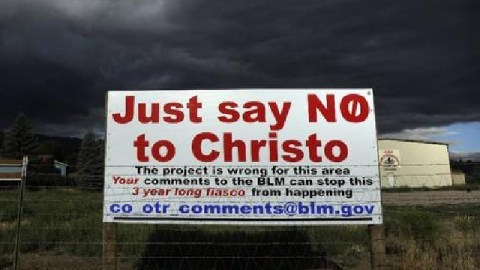Is Christo Bad for the Environment?

Like doctors, artists should obey one rule above all, “To do no harm.” When you’re Christo and you specialize in “environmental art,” that rule takes on an even greater importance. Christo’s latest project, titled “Over the River,” hopes to hang 5.9 miles of “silvery, translucent” panels along the Arkansas River between Canon City and Salida, Colorado. The people of Colorado, however, fearing a whole slew of negative effects to their home state, hope to hang up the process long enough to make Christo give up. In looking back at Christo’s past works and at the possible effects of this future piece, it’s imperative that we ask if Christo is bad for the environment.
Rags Over the Arkansas River (aka, ROAR; one of their signs above) argues in their lawsuits that the approximately 9,000 bores Christo plans to drill to anchor the 925 fabric panels would harm local wildlife (Bighorn sheep, elk, deer, eagles, etc.), attract excessive traffic, and interfere with recreational activities around the river. “Installing the anchor bolts and other hardware requires large drilling equipment normally used for mining and heavy construction activities,” ROAR argues in their suit. “The art project is, in fact, more similar to mineral resource extraction and development than recreation.” The Bureau of Land Management (aka, BLM), however, approved “Over the River” using the guidelines of the National Environmental Protection Act and even added more than 100 conditions to Christo’s proposal expressly to protect the land and all forms of life on it. Christo’s picking up all $50 million necessary for the job, so you can’t argue against use of public money. ROAR still roars against the BLM’s decision, and the noise will continue all the way up to August 2014, when “Over the River” will stand for 2 unforgettable (in every meaning of the word) weeks.
ROAR brought up all the past problems of Christo’s projects in their suit. In 1991, a 485-pound yellow umbrella from the international “The Umbrellas” project came loose in high winds and killed a woman in California. (Christo had the 3,000 plus umbrellas in California and Japan closed immediately.) After “Running Fence” appeared in California in 1976, Christo paid $60,000 in fines for not obtaining all the proper permits, something that ROAR wants to use as proof that Christo doesn’t always play by the rules. Christo’s history with Colorado also haunts him—specifically the fiasco of “Valley Curtain,” when a 400-meter long cloth stretched across a canyon gap came apart in fierce winds after only 28 hours.
Christo always goes big, for good and ill. He and his late wife, Jeanne-Claude, aimed at making people gain a new appreciation for their surroundings by draping them in color and interesting textures. If that’s the goal, then “Over the River” may have already achieved it. The people of Colorado, led by ROAR, are looking more closely at their surroundings and how they can keep it safe. I don’t know if Christo’s bad for the environment or not, but it sounds to me that he might want to look elsewhere to spend his $50 million in pursuit of enlightenment.





